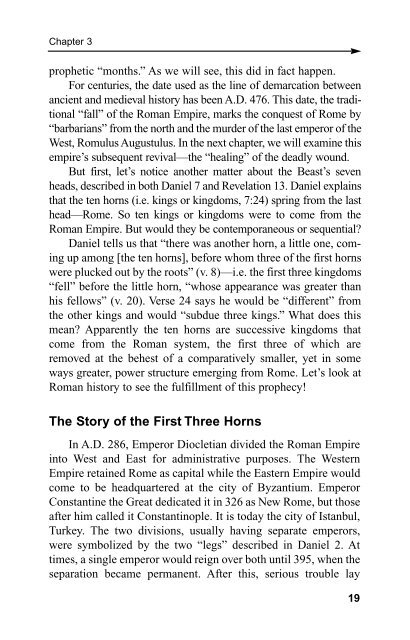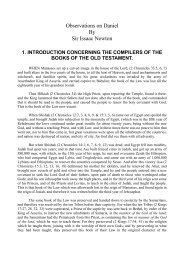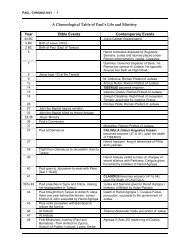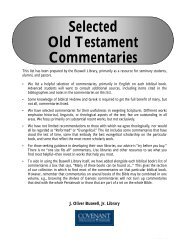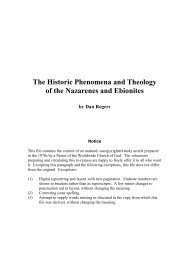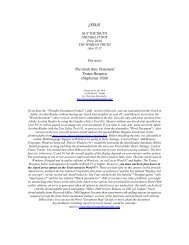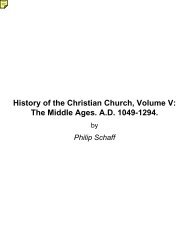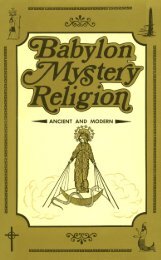Beast of Revelation.pdf - Friends of the Sabbath Australia
Beast of Revelation.pdf - Friends of the Sabbath Australia
Beast of Revelation.pdf - Friends of the Sabbath Australia
You also want an ePaper? Increase the reach of your titles
YUMPU automatically turns print PDFs into web optimized ePapers that Google loves.
Chapter 3<br />
prophetic “months.” As we will see, this did in fact happen.<br />
For centuries, <strong>the</strong> date used as <strong>the</strong> line <strong>of</strong> demarcation between<br />
ancient and medieval history has been A.D. 476. This date, <strong>the</strong> traditional<br />
“fall” <strong>of</strong> <strong>the</strong> Roman Empire, marks <strong>the</strong> conquest <strong>of</strong> Rome by<br />
“barbarians” from <strong>the</strong> north and <strong>the</strong> murder <strong>of</strong> <strong>the</strong> last emperor <strong>of</strong> <strong>the</strong><br />
West, Romulus Augustulus. In <strong>the</strong> next chapter, we will examine this<br />
empire’s subsequent revival—<strong>the</strong> “healing” <strong>of</strong> <strong>the</strong> deadly wound.<br />
But first, let’s notice ano<strong>the</strong>r matter about <strong>the</strong> <strong>Beast</strong>’s seven<br />
heads, described in both Daniel 7 and <strong>Revelation</strong> 13. Daniel explains<br />
that <strong>the</strong> ten horns (i.e. kings or kingdoms, 7:24) spring from <strong>the</strong> last<br />
head—Rome. So ten kings or kingdoms were to come from <strong>the</strong><br />
Roman Empire. But would <strong>the</strong>y be contemporaneous or sequential?<br />
Daniel tells us that “<strong>the</strong>re was ano<strong>the</strong>r horn, a little one, coming<br />
up among [<strong>the</strong> ten horns], before whom three <strong>of</strong> <strong>the</strong> first horns<br />
were plucked out by <strong>the</strong> roots” (v. 8)—i.e. <strong>the</strong> first three kingdoms<br />
“fell” before <strong>the</strong> little horn, “whose appearance was greater than<br />
his fellows” (v. 20). Verse 24 says he would be “different” from<br />
<strong>the</strong> o<strong>the</strong>r kings and would “subdue three kings.” What does this<br />
mean? Apparently <strong>the</strong> ten horns are successive kingdoms that<br />
come from <strong>the</strong> Roman system, <strong>the</strong> first three <strong>of</strong> which are<br />
removed at <strong>the</strong> behest <strong>of</strong> a comparatively smaller, yet in some<br />
ways greater, power structure emerging from Rome. Let’s look at<br />
Roman history to see <strong>the</strong> fulfillment <strong>of</strong> this prophecy!<br />
The Story <strong>of</strong> <strong>the</strong> First Three Horns<br />
In A.D. 286, Emperor Diocletian divided <strong>the</strong> Roman Empire<br />
into West and East for administrative purposes. The Western<br />
Empire retained Rome as capital while <strong>the</strong> Eastern Empire would<br />
come to be headquartered at <strong>the</strong> city <strong>of</strong> Byzantium. Emperor<br />
Constantine <strong>the</strong> Great dedicated it in 326 as New Rome, but those<br />
after him called it Constantinople. It is today <strong>the</strong> city <strong>of</strong> Istanbul,<br />
Turkey. The two divisions, usually having separate emperors,<br />
were symbolized by <strong>the</strong> two “legs” described in Daniel 2. At<br />
times, a single emperor would reign over both until 395, when <strong>the</strong><br />
separation became permanent. After this, serious trouble lay<br />
19


